
IP NEWS IN JAPAN
Cross-border use of trademarks on the Internet, and Trademark Protection in Virtual Spaces and in light of generative AI Technology
The 12th session of the Trademark System Subcommittee, the Intellectual Property Committee under the Japan Patent Office (JPO) Industrial Structure Council was held on June 13, 2025 and “Subjects for consideration related to the Trademark System” was published.
[Subjects]
(1) Cross-border use of trademarks on the Internet
(2) Trademark Protection in Virtual Spaces
(3) Trademark Protection in light of the development of generative AI Technology
(1) Cross-border use of trademarks on the Internet
[Problems]
➢When a trademark is displayed in a transaction on the Internet, such use may fall, for example, under commercial use of a trademark (Article 2(3)(viii) of the Trademark Act)
➢While the principle of territoriality applies to the scope of trademark rights, the use of a trademark on the Internet may be problematic as to whether it constitutes use in Japan.
➢An example is a case where a Japanese registered trademark is displayed on an online shopping site located on an overseas server.
[Court decisions]
Suits to rescind a trial decision of a trial for non-use cancellation
① Decision on “PAPA JOHN’S” case rendered on December 20, 2005 by Intellectual Property High Court (Case Number: 2005(Gyo-Ke)No.10095)
– A registered trademark “PAPA JOHN’S” for designated goods “pizza” was displayed on a webpage established on a server in the U.S.
– The defendant (trademark right holder of “PAPA JOHN’S”) alleged that an act of advertising “pizza” on its webpage constitutes the “use of a trademark” (Article 2 (3)(viii) of the current Trademark Act).
– The court’s holding is as follows: The defendant’s webpage is “established on a server in the U.S and displayed only in English, and therefore is not found to have been targeted for Japanese consumers. While defendant’s webpage is also accessible from Japan and searchable through Japanese search engines, this is a matter of course for an Internet webpage and does not provide sufficient grounds to consider that the advertisement through the aforementioned webpage constitutes use of the trademark in Japan.”
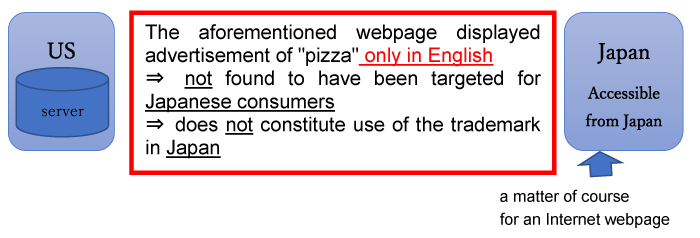
② Decision on “COVERDERM” case rendered on November 29, 2017 by Intellectual Property High Court (Case Number: 2017(Gyo-Ke)No.10071)
– A registered trademark “COVERDERM” for designated goods “cosmetics” was displayed on a website established on a server (location unknown).
– The plaintiff (trademark right holder) alleged that they used the registered trademark for cosmetics on their website.
– The court’s holding is as follows: “Since the plaintiff’s website introduces the history and actual situation of the brand related to the plaintiff’s trademark in Japanese and even the order form and the send button are written in Japanese, it is clear that the plaintiff’s website is an ordering site targeted for Japanese consumers, even considering the fact that the product introduction at the link is written in English. Then, the plaintiff is at least found to have conducted use of the plaintiff’s trademark in Japan referred to in Article 2(3)(viii) of the Trademark Act during the evidence-required period setting aside the question of whether or not it can be recognized as far as that goods bearing the plaintiff’s trademark were delivered to Japanese consumers.”
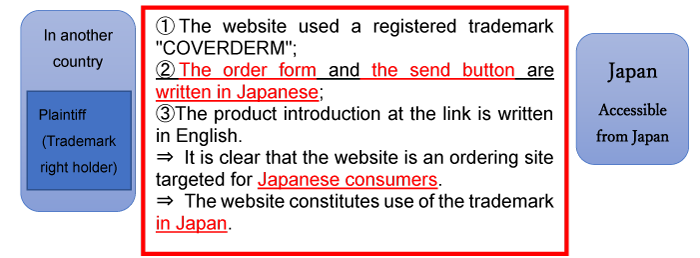
③ Decision on “AROMA ZONE” case rendered on January 28, 2020 by Intellectual Property High Court (Case Number: 2019(Gyo-Ke) No.10078)
– A registered trademark :

for designated goods “containers for household or kitchen use” was displayed on an online shop run by a Japanese resident in France (“l’Ange bio”)
– Pointing to the facts that the online shop is operated in Japanese and sells products to Japan, and prices are displayed in Japanese yen, the court held that the use of the present trademark constitutes use in Japan because “it can be inferred that the products were assigned to Japanese consumers with the present trademark affixed thereto, and it is at least clear that l’Ange bio displayed the products for assignment.”
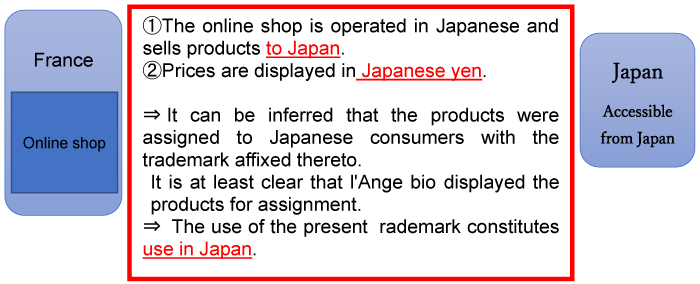
(2) A trademark infringement suit related to cross-border use of trademarks on the Internet
– The plaintiff argued that defendant’s use of “Sushi Zanmai” on their website constitutes a trademark infringement based on plaintiff’s Japanese registered trademark “SUSHI ZANMAI” (designated service: providing foods and beverages mainly Sushi).
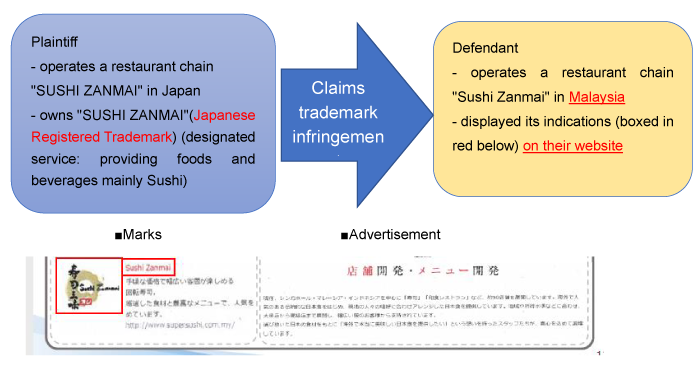
1. First instance decision: rendered on March 19, 2024 by Tokyo District Court (Case Number: 2021(Wa) No.11358)
The first instance decision evaluated that the defendant “used” the plaintiff’s trademark (Article 2 (3) (viii) of the Trademark Act) on the grounds that defendant’s act of displaying their trademark “Sushi Zanmai” on its website would impair the origin-indicating function and the quality-guarantee function of the plaintiff’s trademark, and the court recognized trademark infringement.
The court held that “even if the defendant’s trademark is related to their sushi restaurants in Malaysia, the act of having placed the defendant’s trademarks on the webpages would impair the origin-indicating function and the quality-guarantee function of the plaintiff’s trademark in Japan, and would therefore be against the aforementioned purpose of the Trademark Act.”
2. Appeal court decision: rendered on October 30, 2024 by Intellectual Property High Court (Case Number: 2024(Ne) No.10031)
The appeal court decision did not recognize trademark infringement on the following grounds:
①use of the defendant’s trademarks on their webpages cannot be found to constitute use of the trademark as “advertisement related to services” of the sushi restaurants; and
②even if the use of the defendant’s trademarks on their webpages constitutes use of the trademark, the defendant’s trademarks are not used for provision of services in Japan.
The appeal court decision did not recognize trademark infringement based on the following:
(1) The defendant’s webpages are found to be intended to introduce that the defendant is engaged in business of exporting fresh, high-quality seafood and fishery products from Japan to be served by chain restaurants serving Japanese food in Southeast Asia, and therefore that the defendant’s webpages are not fount to constitute “advertisement related to services” of their sushi restaurants.
(2) Even if use of the defendant’s trademarks on their webpages were to be considered to constitute use of the trademark as “advertisement” in terms of making the existence of their sushi restaurants widely known in Japan and therefore constitutes “use as a trademark,” their webpages are found to be intended for domestic businesses considering exporting foodstuffs overseas. Moreover, since their sushi restaurants are found to be providing services of providing foods and beverages outside Japan (Singapore and Malaysia), their sushi restaurants are not found to provide similar services in Japan.
(3) The appeal court decision cites Joint Recommendation Concerning The Protection Of Marks, and Other Industrial Property Rights In Signs,On The Internet issued by the WIPO (“Joint Recommendation”), applies the Joint Recommendation to this case, states that above interpretations are consistent with the Joint Recommendation, and concluded that use of the defendant’s trademarks on their webpages does not constitute use as a trademark in Japan. When the factors for determining commercial effect referred to in Article 3(1) of the Joint Recommendation are examined, the following are observed:
the defendant’s sushi restaurants do not provide services in Japan and there are no circumstances indicating that the defendant has undertaken plans to provide such services in Japan (Article 3(1) (a));
the defendant’s webpages do not display prices of their sushi restaurants in Japanese yen (Article 3(1) (c)(ii)); and
no contact information in Japan is provided on the webpages (Article 3(1) (d)(ii)).
In addition, the following circumstances are also found: the purpose of the defendant’s webpages themselves is to serve as advertisement of services of exporting foodstuffs from Japan, and the defendant’s trademarks are used in the context of introducing foreign restaurant chains that use those foodstuffs exported from Japan.
When these circumstances are comprehensively considered, even in light of the facts that the defendant’s webpages are created in Japanese (Article 3(1)(d)(iv)), and that the defendant’s webpages do not explicitly indicate that they have no intention to provide services of their sushi restaurants to customers in Japan ((Article 3(1)(b)(ii)), it is not considered that the use of the defendant’s trademarks on their webpages has a commercial effect in Japan, and therefore should be considered as not constituting use as a trademark in Japan.
① Summary
➢The factors pointed out in court decisions and the WIPO Joint Recommendation are useful to determine whether cross-border use of a trademark on the Internet constitutes use of a trademark in Japan under the Trademark Act.
➢Comprehensively considering those factors, where use of a trademark is evaluated as being targeted for Japanese consumers, the use is considered to constitute use of a trademark in Japan.

While it is necessary to continue to closely watch the discussions in the Patent System Subcommittee, it is considered that the current Trademark System addresses cross-border use of trademarks on the Internet to a certain extent.
- Factors considered in court decisions
– whether or not business is conducted for Japan;
– whether or not the webpages are displayed in Japanese;
– whether or not prices are displayed in Japanese yen in the webpages; and
– whether or not contact information in Japan is provided on the webpages.
- Factors considered in the WIPO Joint Recommendation
– whether or not the user of the sign is doing business in a Member State;
– whether or not the user of the sign has stated that he does not intend to deliver the goods or services offered to customers located in the Member State;
– whether or not the official currency and a language used in the Member State are used;
– whether or not an address, telephone number or other means of contact in the Member State is used in conjunction with the use of the sign; and
– whether or not the use of the sign is supported by a right in the sign in the Member State.
For details of the WIPO Joint Recommendation, please refer to the following webpage:
Joint Recommendation Concerning Provisions on the Protection of Marks, and Other Industrial Property Rights in Signs, on the Internet (with Explanatory Notes)
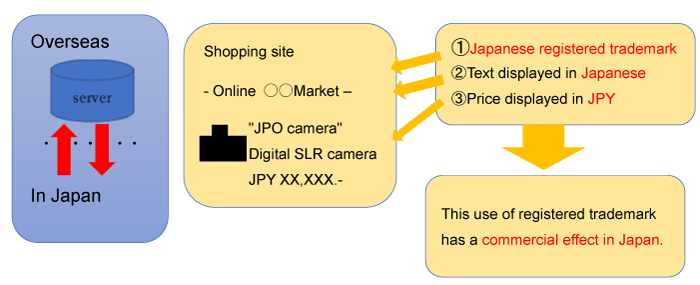
- Trademark Protection in Virtual Spaces
(1) The development of VR technology has improved the realism and immersiveness of virtual spaces, making it possible for people to have virtual space experience comparable to real space experience, and various businesses based on the use of virtual spaces are being developed.
Business entities based on the use of virtual spaces are broadly classified into the following two categories:
(A) Businesses mainly engage in business related to real spaces (hereinafter referred to as “real-world business entities”); and
(B) Businesses mainly engaged in business related to virtual spaces (hereinafter referred to as “virtual-space business entity”).
*Virtual goods mean digital data for displaying the shape of products in virtual spaces (examples include data of an article of clothing worn by an avatar, and data of an article of furniture installed in a virtual space).
*When trademarks are used to advertise actual goods, they are protected by registration by filing an application designating conventional classes and goods (examples include a case where a business entity in a real space displays a 3D model or the like bearing a trademark in a virtual space for the sole purpose of advertising real goods).
(2) Registrability of trademarks for virtual goods
➢Under the Trademark Act, trademarks for virtual goods can be protected by registration under current act. Trademarks for virtual goods can be protected by registration by filing an application by designating an indication for virtual goods (examples: Class 9 “downloadable virtual clothing” and Class 41 “providing online images for displaying clothing in virtual environments“).
Based on international discussions, the JPO formulated guidelines on acceptable indications for virtual goods and published the formulated guidelines in March 2024 (the guidelines were revised in January 2025).
For specific registration examples, please refer to the following web page:
JPO “Guidelines for Designated Goods and Designated Services Related to Virtual Environments and Non-Fungible Tokens (NFTs)”
https://www.jpo.go.jp/e/system/laws/rule/guideline/trademark/guideline_virtual-nfts.html
Reg.No.6753277
Registration date:Nov.10,2023
Right holder Name:ZOZO, Inc.
Mark:

Classes of goods and services and designated goods or designated services
Class 9
Computer programs for clothing, hats, footwear, athletic specialty clothing, athletic specialty shoes, athletic equipment, eyeglasses, sunglasses, belts, bags, bags, umbrellas, masks, headgear, jewelry, personal adornments, key holders, stickers, stationery, toys, dolls, game equipment, furniture, watches, household linen products and other virtual goods for use in online, online virtual, augmented or mixed reality environments; Computer software or computer programs for virtual simulations such as try-on and placement of clothing, hats, footwear, special athletic clothing, special athletic shoes, athletic equipment, eyeglasses, sunglasses, belts, bags, bags, umbrellas, masks, headgear, jewelry, personal adornments, key holders, stickers, stationery, toys, dolls, game equipment, furniture, watches, household linen products and other virtual goods; Computer software or computer programs for virtual reality, augmented reality and mixed reality, etc.
Class 35
The provision of benefits to customers in the course of retail or wholesale business of computer programs whose contents are clothes, hats, footwear, special sports clothes, special sports shoes, sports equipment, glasses, sunglasses, belts, bags, bags, umbrellas, masks, headgear, jewelry, personal ornaments, key holders, stickers, stationery, toys, dolls, game equipment, furniture, watches, household linen products and other virtual goods for use in online, online virtual environment, augmented reality environment or mixed reality environment, etc.
Class 41
Provision of non-downloadable images or videos of clothing, hats, footwear, special athletic clothing, special athletic shoes, sports equipment, eyeglasses, sunglasses, belts, bags, bags, umbrellas, masks, headgear, jewelry, personal ornaments, key holders, stickers, stationery, toys, dolls, game equipment, furniture, watches, household linen products and other virtual goods for use in an on-line, on-line virtual environment, augmented reality environment or mixed reality environment; Provision of online music, audio, video, images, and character information, and provision of related advice or information, etc.
Class 42
Provision of computer programs for clothing, hats, footwear, special athletic clothing, special athletic shoes, sports equipment, eyeglasses, sunglasses, belts, bags, bags, umbrellas, masks, headgear, jewelry, personal adornments, key holders, stickers, stationery, toys, dolls, game equipment, furniture, watches, household linen products and other virtual goods for use in online, online virtual environment, augmented reality virtual environment or mixed reality virtual environment, etc.
(2) Summary
<Registrability of trademarks for virtual goods>
In the Trademark System, trademarks for virtual goods can be protected by registration under current act.
(1) If there is a registered trademark of another person for real goods that is identical or similar to a trademark for virtual goods, the trademark for the virtual goods is registrable in principle, since virtual goods and real goods are presumed to be dissimilar in principle.
(2) If there is a registered trademark of another person for virtual goods that is identical or similar to a trademark for virtual goods, the trademark for the virtual goods is unregistrable in principle, since virtual goods are presumed to be similar to each other in principle.
<Enforcement of trademark rights against use of a trademark for virtual goods>
(1) If another person uses, for virtual goods, a trademark that is identical to or similar to a registered trademark for real goods, trademark rights for the real goods cannot be enforced in principle unless the virtual goods and the real goods are found to be similar.
(2) If another person uses, for virtual goods, a trademark that is identical to or similar to a registered trademark for virtual goods, trademark rights for the virtual goods can be enforced in principle if the virtual goods are found to be similar to each other.

While it is necessary to continue to closely watch the actual situations of virtual space business, trends in judicial decisions, trends in other countries, and discussions in the Design System Subcommittee, it is considered that trademarks for virtual goods are protected to a certain extent under the current Trademark System.
(3) Trademark Protection in light of the development of generative AI Technology
With the development of generative AI technology, tools utilizing generative AI technology are becoming widespread, and it is now possible to generate and use a large amount of characters, figures, etc. in a short time by inputting text, images, etc.
It should be examined whether there is any impact on the Trademark System when an application is filed for a trademark containing characters, figures, etc. created using generative AI (hereinafter referred to as “AI product”) or when such a trademark is used, or when AI is made to learn data containing registered trademarks.
Summary
➢ As summarized below, making AI to learn registered trademarks does not constitute an act falling within the scope of trademark rights. Even where an application is filed for a trademark containing an AI product or rights of such a trademark is to be enforced, it is considered that, in principle, such a trademark application or trademark rights are treated in the same way as conventional trademark applications or trademark rights.
<① Learning stage>
Does an act of making AI to learn data containing other people’s registered trademarks fall within the scope of trademark rights?
⇒ Even if it is registered trademarks that are used as AI learning data, such use of trademarks does not fall under the “use” as provided in each item of Article 2 (3) of the Trademark Act. Therefore, such an act does not fall within the scope of trademark rights.
<② Generation and use stage>
How is trademark infringement determined for an act of using an AI product containing other people’s registered trademarks?
⇒ Since reliance is not required as a requirement for infringement of rights, and it is difficult to assume AI-specific factors for similarity determination, Therefore, the determination of infringement of trademark rights concerning AI products is made in a manner similar to that of conventional determination of infringement.
<③ Registrability of trademarks for AI products>
Is a trademark containing an AI product registrable?
⇒The purpose of the Trademark Act is to ensure upholding the reputation of businesses of persons who use trademarks and to protect the interests of consumers, but not to protect the creations by natural persons. Therefore, regardless of whether a trademark is created by a natural person or AI, the trademark can be registered as long as it does not fall under the rejection reasons provided for in Articles 3 and 4 of the Trademark Act, as in the case of a conventional trademark registration application.
Sources:
Original document in the JPO website (Full Text: Japanese)


